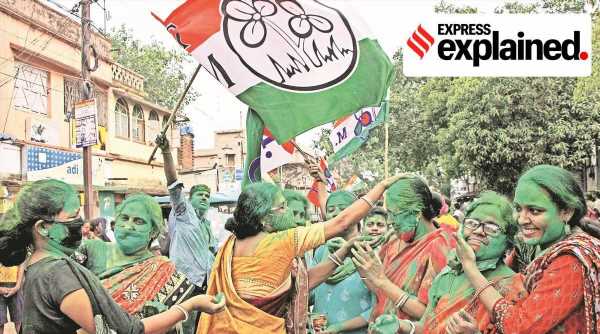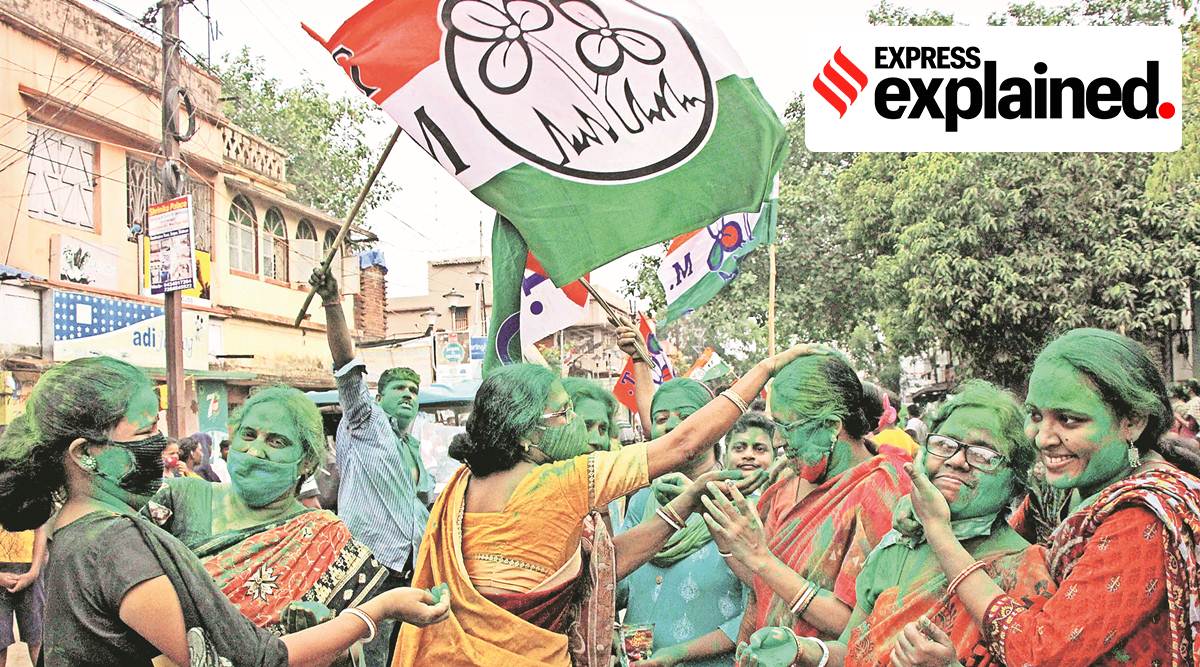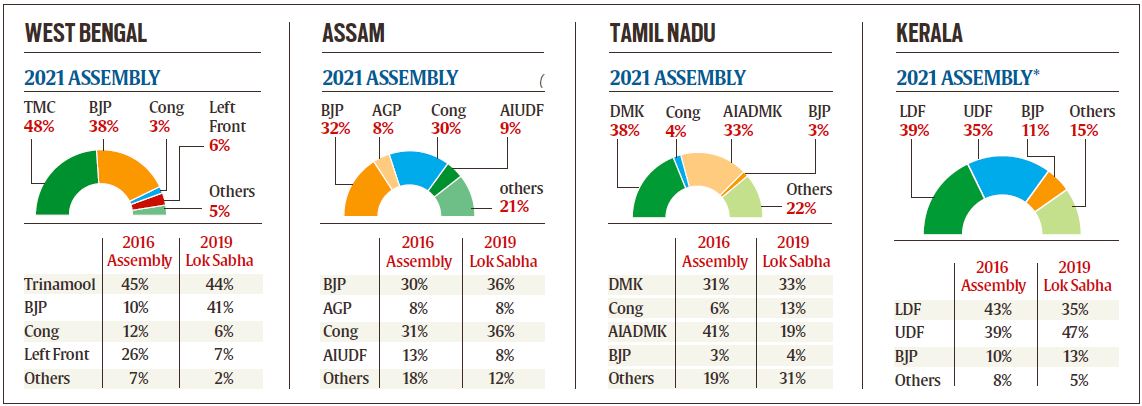On Sunday afternoon, without a wheelchair for the first time in a few weeks, it was Chief Minister Mamata Banerjee who spoke to the people of the state as the victor. What are the factors that led to the result?
For the BJP, May 2 was to be a crowning moment, when they would win West Bengal. An election campaign that lasted for over a month saw the presence of a battery of central ministers, including Home Minister Amit Shah and Prime Minister Narendra Modi. But on Sunday afternoon, without a wheelchair for the first time in a few weeks, it was Chief Minister Mamata Banerjee who spoke to the people of the state as the victor. What are the factors that led to the result?
Welfare web
Three years after a huge win in the 2016 elections, the 2019 Lok Sabha elections were a wake-up call for the Trinamool Congress. The BJP won 18 of 40 seats, and over 40% of the vote. It was then that the Trinamool doubled down on its already extensive welfare web for the poor, bringing in Duare Sarkaar, and Didi ke Bolo, a campaign where complaints could be made to a centralised phone number. Over the last one decade, the Trinamool had instituted several schemes such as Rupashree, Kanyashree, and Sabooj Saathi that saw monetary benefits for the underprivileged. The BJP framed these schemes as centres of corruption by Trinamool leaders. On the ground, two things were evident. First, the Trinamool had focused on making the schemes more accessible to people, with Duare Sarkaar and Didi Ke Bolo also giving the party information on where they were going wrong. For instance, Triinamool leaders said one of the most common complaints was the lack of SC certificates in some areas, which were then freely distributed. Second, the central focus of many of these schemes were women, a constituency that has stayed loyal to Mamata Banerjee. Across districts, even if men of a household were voting for the BJP, many women of the same household were staying with Mamata.
Newsletter | Click to get the day’s best explainers in your inbox
Battle of personalities
As the campaign progressed, the elections devolved into a battle of personalities, Chief Minister Mamata Banerjee versus Prime Minister Narendra Modi, and to an extent Home Minister Amit Shah. This ended up suiting the Trinamool. For, it is clear that while there was anger on the ground against local-level violence and petty corruption, this was against the Trinamool and not against Mamata herself; she retained her popularity as Bengal’s matriarch, with people blaming the local party cadres for their troubles. The party then designed its campaign around the personality of Mamata Banerjee, the streetfighter, wheelchair-bound but still fighting. The BJP too made her the centrepiece of its attack, with the Prime Minister’s “Didi, o Didi” remark becoming a leitmotif in the elections. But this was no 2019, and people on the ground were aware that Modi was not on the ballot for Chief Minister of West Bengal. On the ground, while Modi was not unpopular, he was not at the forefront of conversations and would only be talked about when a question about him was asked. And the taunt, or the focused criticism of Mamata, was not received well.
Politics of polarisation
Religious polarisation was at the centre of the campaign all through. While the BJP accused the Trinamool of “Muslim appeasement”, and used the slogan “Jai Shri Ram” almost as a political slogan, Mamata and the Trinamool had to walk a tightrope, even reciting the Chandipath during the campaign. Eventually, the polarisation seemed to work for one side better than the other. Faced with the prospect of the BJP coming to power, the Muslim community, even in strongholds of the Congress and the Left, chose to side with the Trinamool. On the other hand, the BJP set itself an Everest-like target of winning Bengal without the close to 30% Muslim vote. This required an extremely high level of polarisation among Hindus, which did not happen. Mamata’s outreach, and her decision not to overtly fall into the religious binary, paid off, with the Trinamool increasing its vote share from 2019, and widening the gap with the BJP whose share fell.
Organisational differences
The run-up to the campaign was headlined by high-profile shifts from the Trinamool to the BJP, from ministers Suvendu Adhikari and Rajib Banerjee to powerful local leaders like Jitendra Tiwari from Asansol. While this was broadly read at as a shifting of the political sands, it allowed Mamata to create a siege mentality around herself and her party. Much of the imaging became of Mamata fighting the BJP’s resources by herself, the narrative lending itself to the insider-outsider trope as the Chief Minister called the BJP “bargis” (plunderers). At the ground level, Trinamool leaders fought the elections with its backs to the wall, with many desperate to show those that left their place. The BJP on the other hand, with the new entrants, uncharacteristically appeared ideologically hollow. Differences over seat distribution emerged among the old guard of the BJP, those from the Left that joined the party only to defeat the Trinamool, and new entrants from the Trinamool itself. In fact, while the BJP would argue that it would not have had the organisational strength to take on the Trinamool if the inductions were not made, that made for a contradiction on the ground. For a party that was pitching itself against the Trinamool as non-violent and non-corrupt, many of its candidates inducted from the Trinamool faced their own local allegations of corruption and violence.
Little to offer from BJP
The BJP campaign fundamentally hinged on two factors, anti-incumbency and alleged Muslim appeasement, and therefore religious polarisation. Wherever the conversation in constituencies turned local, to MLAs, to organisation, to the identification of the Chief Minister, or the alternatives the BJP was providing, the BJP lost the argument. While the BJP had a manifesto, not one promise of the manifesto was invested in as part of a sustained campaign pitch, as an alternative to the Trinamool’s welfare schemes. With the central leadership taking ownership of the campaign, and no clarity on which of the lieutenants, Suvendu Adhikari, or Mukul Roy or Dilip Ghosh or anyone else would be chief ministerial candidate, there was no answer to the question of who else but Mamata. Despite its publicity and rally blitzkrieg, the BJP was not able to convince voters that it would win. So even in places where Trinamool candidate or the party itself was unpopular, with people even fearful of local hooliganism, the safer choice was to stay with the Trinamool. The party’s organisation stood intact.
Source: Read Full Article



